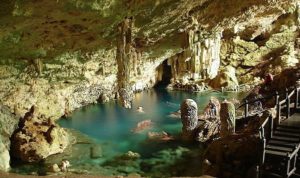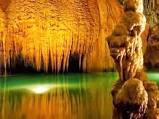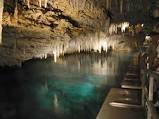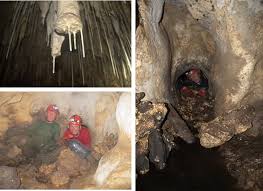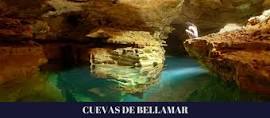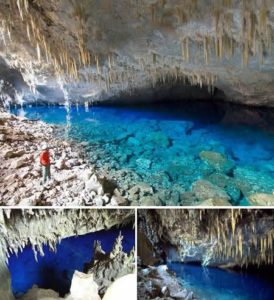
CUBA Y SUS BELLEZAS NATURALES: LAS CUEVAS DE BELLAMAR. PHOTOS.
Las Cuevas de Bellamar son un conjunto de cuevas con más de 23 kilómetros de galerías ubicadas en la provincia de Matanzas, Cuba. Por la belleza de sus galerías y cuevas, los importantes hallazgos paleontológicos, así como una amplia gama de procesos cristalinos, fueron declarados Monumento Nacional.
Las galerías y pasajes de las cuevas comenzaron a formarse hace unos 30 millones de años. Originalmente la llanura en la que se encuentran las cuevas estaba bajo el mar, formaba parte de la Bahía de Matanzas. Durante el fallo de llamada de las aguas subterráneas de Bellamar, en combinación con el dióxido de carbono se fue disolviendo la piedra caliza y creando así cámaras subterráneas en el subsuelo bajo el lecho marino. Mientras estas cuevas permanecieron bajo el nivel del mar se llenaron de agua. Luego, con consecuencias tectónicas (movimientos en las capas de la tierra), esta zona se elevó, formando terrazas marinas que se notan en el terreno en la ciudad de Matanzas y sus alrededores.
Finalmente, las cavernas se secaron; desaguándose incluso cavidades que se encuentran muy por debajo del nivel del mar. Después comenzaron las filtraciones entre las rocas del techo de las cuevas. Las filtraciones de agua con carbonato cálcico disuelto dejaban residuos que se filtraban, formando estalactitas que colgaban del techo y estalagmitas en el piso. Las estalactitas son cilíndricas al principio, a medida que aumenta su tamaño toman la forma cónica. Las estalagmitas suelen ser cónicas o aplanadas, ya que se derriten. Las estalactitas y estalagmitas crecen bien, formando columnas cuando las dos se juntan. En algunos casos varias estalactitas son relativamente vallas y aumentan sus proporciones a medida que se unen, dando como resultado las formaciones llamadas formatos. Otras veces están cerca de la pared, y esas son las cascadas. En las Cuevas de Bellamar están todas estas formaciones y aún más interesante es que a pesar de los años que ya se tienen en cuanto a cuevas son relativamente jóvenes, lo que en lenguaje común significa que incluso estas formaciones están surgiendo y lo familiar, creciendo.
Algo muy interesante de las Cuevas de Bellamar es que también tienen formaciones cristalinas de aspecto transparente y brillante. Estas formaciones no se originan de la misma manera que las estalactitas y otras estructuras descritas anteriormente. Estos cristales son causados por bolsas llenas de agua. Aún más interesante es que en ciertos focos de formaciones sedimentarias las cuevas están cubiertas por una capa cristalina. Esto indica que después del secado, se vuelven a inundar estas cámaras por completo, o al menos parcialmente. Estas cuevas tienen una belleza poco común en el mundo de las cuevas y muchas de las formaciones son brillantes debido a la capa cristalina que las cubre.
La entrada a la cavidad Cuevas de Bellamar se llama Sala Gótica. Es una cámara en un patrón de cuadrícula y mide 80 metros de largo y 25 metros de ancho. En esta sala has nombrado algunas de las formaciones, entre otras está el Jardín de las Zanahorias, La Capilla de los Doce Apóstoles, Doña Mamerta, y quizás la más famosa es el Manto de Colón. Pero las Cuevas de Bellamar no son solo esta sala, la cavidad se extiende hacia el este y el oeste logra una longitud que supera los tres kilómetros de largo, y se estima que será mucho más grande y aún las cámaras están completamente inundadas. También hay al menos otra cavidad casi paralela al norte. Otras cavidades son el Salón de los Dos Lagos, el Salón de las esponjas, la Galería de los Enanos y el Salón de Megalocnus al este del Salón Gótico. En la otra dirección están el paso de Hatuey, el Ladies Room, el lago de las Dalias y American Bath (antes de los ingleses).
Estas cuevas fueron descubiertas por casualidad. En febrero de 1861 un esclavo perdió su palanca para abrir un agujero en el suelo tratando de sacar una piedra caliza. Aparentemente, el esclavo, e incluso el capataz, imaginaba que la tierra se había tragado a Jimmy porque eso causaba terror. Don Manuel Santos Parga, dueño de la finca donde se encontraba la cantera de estas rocas fueron llevados a un horno de cal que también se encontraba en ese lugar, pedir explicaciones, y dos meses después de no recibir respuesta acudió al lugar de los hechos.
Joseph V. Betancourt, quien narró lo sucedido en 1863, dice: “Es como si el capataz viera que Parga no obedecía sus órdenes y dos meses consecutivos, un día lo dejaba con la gente (el capataz y los esclavos) hasta el punto de que había desaparecido”. (Jimmy) está pidiendo trabajase ahí, y acababa de abrir un espacio de poco más que un palo, salió del agujero hizo una corriente de olor desagradable, caliente y como ahumado, no se retiró a Parga que, sino al contrario, siguió La obra se pudo convencer de que se trataba de la entrada a una cueva y el coraje rayano en la imprudencia siguió ensanchando la abertura y luego se aventuró en un descenso utilizando una escala que era necesaria para alargarla y llegando a ella parecía que el suelo se encontraba envuelto en tinieblas. como era muy conveniente en mi punto, no se desanimó y se dispuso a explorar la cueva, sin embargo, dominado por la idea de que había algo: Colón estaba vislumbrando el Nuevo Mundo … ”
Este hombre Parga, como se menciona en la historia, fue entendido en materia de minas y cuevas. Inmediatamente me di cuenta de lo que significaba el descubrimiento y comencé a preparar la cueva para que los visitantes pudieran disfrutarla. Se necesitaron muchas piedras, fueron escaleras de concreto que aún están en uso, a las escaleras se le instalaron pasamanos, y pronto se hizo realidad, se instaló electricidad. Luego, él o uno de los guías a su cargo llevaron a los turistas por los pasillos de la cueva mientras explicaban en detalle lo que estaban viendo. Recuerde que en esa época la playa de Varadero aún estaba en los mosquitos y la sal. Las ciudades tenían mucha menos gente y Henry Ford tuvo que inventar la línea de montaje, tenían coches. Aún así, en los dos primeros años Parga abrió su cueva al público, más de dos mil personas la visitaron. En aquellos días, un éxito turístico tanto como científico. Un éxito que ya tiene más de ciento cuarenta años y que aún continúa como lo hizo el Sr. Parga.
Originalmente se llamó La Cueva de Parga, que como sabemos fue el dueño de la propiedad donde se descubrió la cueva, el primero en explorar y el primero en mostrarles el mundo. De hecho, según los científicos es una única cueva con varias habitaciones, pero como es costumbre en el plural, y en el presente. Poco tiempo después cambió el nombre a Las Cuevas de Bellamar por su cercanía a la playa Bellamar, al oeste de la ciudad de Matanzas y la costa de la bahía, donde en ese momento se había comenzado a construir una casa de veraneo.
Como se mencionó, los tramos que se han explorado tienen una longitud total de 3.225 metros (poco más de tres kilómetros). Hay varias galerías que corren paralelas y en varios niveles. En total tienen una longitud de unos veinte kilómetros, lo cual es considerable pero no sorprendente en el inframundo, la Cueva del Mamut en Kentucky, EE. UU., Alcanzó unos 580 kilómetros. Claro, se estima que en las Cuevas de Bellamar aún hay mucho más por conocer y Mammoth Cave es una de las más exploradas del mundo. La que aquí se presenta no es la única formaciones cristalinas. La Cueva de las Joyas en las Black Hills de Dakota del Sur, Estados Unidos, tiene formaciones cristalinas mucho más asombrantes, pero eso no le quita la gracia a Bellamar, que en sí misma es una belleza.
Algunas secciones están dentro de los quince metros por debajo del nivel del mar. Entendemos que a los turistas no se les permite ir tan profundo, más bien la mitad de esa profundidad. El aire es respirable, al menos donde se le permitió llegar al visitante. La temperatura es relativamente estable durante todo el año, permaneciendo en alrededor de 80 º F (26 º C).
 CUBA AND ITS NATURAL BEAUTIES: THE CAVES OF BELLAMAR, CUBA.
CUBA AND ITS NATURAL BEAUTIES: THE CAVES OF BELLAMAR, CUBA.
Bellamar Caves. They are a set of caves with more than 23 kilometers of galleries located in the Matanzas province, Cuba. Due to the beauty of its galleries and caves, the important paleontological finds, as well as a wide range of crystalline processes, they were declared a National Monument.
The galleries and passages of the caves began to form about 30 million years. Originally the plain in which are the caves was under the sea, was part of the Bay of Matanzas. During the call failure Bellamar groundwater, in combination with carbon dioxide was dissolving the limestone and thus creating underground chambers in the subsoil under the seabed. While these caves remained under sea level were filled with water. Then, tectonic consequences (movements in the earth layers), this area was raised, forming marine terraces that are noted in the land in the city of Matanzas and its surroundings.
Eventually, the caverns were drying; desaguándose even cavities that are deep under the sea level. After the leaks began among the rocks on the roof of the caves. The leaks of water with dissolved calcium carbonate were leaving waste were leaking, forming stalactites hanging from the ceiling and stalagmites on the floor. Stalactites are cylindrical at first, as its size increases take the conical shape. Stalagmites are usually conical or flattened, as melted. The stalactites and stalagmites grow well, forming columns when the two come together. In some cases several stalactites are relatively fences and increase their proportions as they are united, resulting in the formations called formats. Other times are close to the wall, and those are the waterfalls. In Bellamar Caves are all these formations and even more interesting is that despite years old already have in terms of caves are relatively young, which in common language means that even these formations are springing up and the familiar, growing.
Something very interesting Bellamar Caves is that they also have crystal formations of a transparent and shiny appearance. These formations do not originate from the same way stalactites and other structures described above. These crystals are caused by water-filled pockets. Even more interesting is that in certain pockets of sedimentary formations caves are covered by a crystalline layer. This indicates that after drying, re-flooding of these cameras completely, or at least partially. These caves have a rare beauty in the world of caves and many of the formations are bright due to the crystalline layer that covers them.
The entrance to the Caves of Bellamar cavity is called Gothic Hall. It’s a camera in a grid pattern and measures 80 meters long and 25 meters wide. In this room you have named some of the formations, among others is the Garden of Carrots, The Chapel of the Twelve Apostles, Doña Mamerta, and perhaps the most famous is the Mantle of Columbus. But Bellamar Caves are not only this room, the cavity extends to the east and west achieved a length that exceeds three miles long, and is estimated to be much larger and still cameras completely flooded. There is also at least one other cavity almost parallel to the north. Other cavities are the Hall of Two Lakes, the Hall of the sponges, the Gallery of the Dwarves, and the Hall of Megalocnus east of the Gothic Hall. In the other direction are the passage of Hatuey, the Ladies Room, Lake of the Dalias, and American Bath (before the English).
These caves were discovered by chance. In February 1861 a slave lost his crowbar to open a hole in the ground trying to remove a lime rock. Apparently, the slave, and even the overseer, imagined that the earth had swallowed Jimmy because that caused terror. Don Manuel Santos Parga, the owner of the farm where he was the quarry of these rocks were taken to a lime kiln was also at that location, ask explanations, and two months after receiving no answer went to the place of the facts.
Joseph V. Betancourt, who narrated what happened in 1863, says: “It’s as if the foreman saw Parga did not obey his orders and consecutive two months, one day left him with people (the overseer and slaves) to the point that had disappeared (Jimmy) ordering is trabajase there, and had just opened a space of little more than a stick, came out of the hole made a draft of smell nasty, hot and as smoky, not retreated to Parga that, but on the contrary, continuing the work could be convinced that this was the entrance to a cave and courage bordering on recklessness continued to widen the opening and then ventured a descent using a scale that was necessary to lengthen and getting to it seemed the ground was found wrapped in darkness. But as he was very convenient in point of mine, was not deterred and set out to explore the cave, however, dominated by the idea that there was something: Columbus was glimpsing the New World … ”
This man Parga, as mentioned in the story, was understood in matters of mines and caves. I immediately realized what the discovery meant and began preparing the cave for visitors could enjoy it. It took many stones were concrete stairs that are still in use, to the stairs was installed handrails, and soon became a reality, installed electricity. Then he or one of the guides under his employment took tourists through the passageways of the cave while explaining in detail what they were seeing. Remember that at that time was still Varadero beach in mosquitoes and salt. The cities were far fewer people and Henry Ford had to invent the assembly line, they had cars. Still, in the first two years Parga opened his cave to the public, over two thousand people visited. In those days, a tourist success both as a scientist. A success which already has over one hundred and forty years and still continues as Mr. Parga did.
Originally it was called La Cueva de Parga, which as we know was the owner of the property where the cave was discovered, the first to explore and the first to show them the world. Indeed, according to scientists is a single cave with several rooms, but as is the custom in the plural, and the present. Shortly after he changed the name to The Caves of Bellamar due to its proximity to the beach Bellamar, west of the city of Matanzas and the coast of the bay, where at that time had begun to build a summer house.
As mentioned, the sections that have been explored with a total length of 3.225 meters (just over three kilometers). There are several galleries running parallel and at various levels. In total they have a length of about twenty miles, which is considerable but not surprising in the underworld, the Mammoth Cave in Kentucky, USA, achieved about 580 kilometers. Sure, it is estimated that in the Caves of Bellamar there is still much more to know and Mammoth Cave is one of the most explored in the world. The one presented here is not the only one crystalline formations. The Jewel Cave in the Black Hills of South Dakota, United States, has much more asombrantes crystalline formations, but that does not take away the grace to Bellamar, which in itself is a beauty.
Some sections are within fifty feet below sea level. We understand that tourists are not allowed to go as deep, more like half that depth. The air is breathable, at least where he was allowed to reach the visitor. The temperature is relatively stable throughout the year, remaining at about 80 º F (26 º C).
Agencies/ Wiki/ Various/ Internet Photos/ YouTube/ Arnoldo Varona/ www.TheCubanHistory.com
THE CUBAN HISTORY, HOLLYWOOD.



 CUBA y Sus Bellezas Naturales: Las Cuevas de BELLAMAR. Photos.
CUBA y Sus Bellezas Naturales: Las Cuevas de BELLAMAR. Photos.